OUR NEW BUNDLE OF JOY
A Guide To Caring For & Training Your Puppy
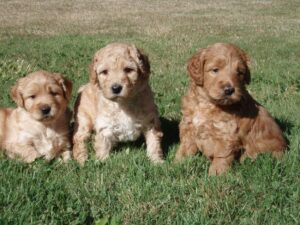
TABLE OF CONTENTS
Vaccines and Safety for Your Puppy . . . . . . . . Page 1
Your First Few Days . . . . . . . . . . . . . …. . . . . . . . Page 2
Housebreaking and Using a Crate . . . . . . . . . . Page 3
When and How to Start Training . . . . . . . . . . . . Page 4
When and How to Start Training. . . . . . . . . . . . Page 5
Puppies and Diarrhea . . . . . . . . . . . . . . . . .. . . . Page 6
How to Treat Diarrhea . . . . . . . . . . . . . . . . . . . . Page 7
Children and Puppies . . . . . . . . . . . . . . . . . . .Page 8 -9
What to Feed and When to Feed it . . . . . . . . . Page 10
Playtime and Chew Toys . . . . . . . . . . . . . . . . . Page 11
Your Labradoodle Puppy . . . . . . . . . . . . . . . . . Page 12
Puppy Proofing Your Home . . . . . . . . . . . . . . . Page 13
How to Handle Problem Behaviors . . . . . . Page 14 -15
Walking on a Leash . . . . . . . . . . . . . . . . . . Page 16 -17
*Don’t forget to sign up for Baxter & Bella Online Training Support! If you use promo code MTVIEW you will save 25%
Page 1
VACCINES AND SAFETY FOR YOUR PUPPY
Your puppy has had his initial vaccine against Parvo, Distemper and other diseases at 7-8 weeks of age. This is the first vaccine in a series of 3 to 4. Once your puppy has been vaccinated, veterinarians then recommend they receive a booster every 3 to 4 weeks, until they reach 16 weeks of age. YOUR PUPPY IS NOT IMMUNE TO THESE DISEASES UNTIL HE’S RECEIVED THE ENTIRE SERIES. Parvo is highly contagious and can be transmitted from dried up feces, shoes, tires, etc. We recommend you not take your puppy to any public areas, parks, etc, until he has completed the full series. If you are traveling by car and must stop to let your puppy go potty, look for an area where no other dogs have gone (no public doggy areas at rest stops). We prefer to take a baggy and let him relieve himself in a non-doggy area, and then clean it up (invert baggie with hand inside and scoop it up, seal bag and dispose).
Your puppy has received a “negative for worms” at our veterinarian’s office, however puppies can pick worms up very easily from exposure to other dogs and feces. We recommend they be checked every few months with a stool sample to your vet while they are still young. Also if you live in an area where there are fleas, along with being an annoying, hard to get rid of pest, they also transmit tapeworms, so you will want to use a product like Advantage or Frontline, to keep your puppy free of fleas. In order to ensure that your flea prevention is working well you should rotate flea medications every six months. We ONLY suggest topical flea meds or a flea collar opposed to the “all in one” oral pill some vets encourage. A wonderful natural option is Wondercide if you’d like to go that direction.
The other product you will want to talk with your veterinarian about is heartworm medication. This would be given monthly, as dogs can be exposed to heartworm from something as simple as a mosquito bite.
Make sure to do a “safety check” around your home and put away any hazardous items that a puppy could get into, i.e.: antifreeze spills, chemical cleaners, small toys they might choke on, large water buckets or toilets and electrical cords they can reach to chew. Also check for poisonous plants that are in reach. Please see the list on page 13.
Page 2
YOUR FIRST FEW DAYS
The first few days you spend with your puppy will be a time of separation and bonding. They will be getting used to the idea of being away from their litter mates and at the same time will bond with you. Don’t be surprised if they howl, whine and yelp loudly during this time. Continue to be loving, assertive and calm and you and your family will become his new “pack”.
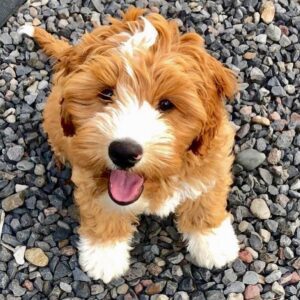
Between 8 to 10 weeks of age is the ideal time for bonding to take place, although it can happen at a later time as well. Your puppy will mirror you, so if you’re calm, they will be calm. If you are excited, they will be excited. Dogs are adaptable and will love unconditionally, providing they’ve not had any negative experiences in their lives.
Your puppy’s training begins the minute you receive them. Everything you do now will either be positive or negative training. You will need to decide what habits yo
u’d like them to have as an adult, and make the necessary adjustments now. For example; would you like your adult, 40 pound dog jumping up on you or up on your furniture? If you allow your cute, little puppy to do this now, you can be sure they will want to continue this behavior as an adult. It is much easier to teach a puppy good habits, then to break them of bad ones. How do you feel about them sleeping in bed with you once they are an adult? Would you like them to bite and chew on your clothing and fingers? Do you want them to bark when people come over? Be thinking about these things in the next few days as everything you do now with your new puppy will have an impact on their life, and yours, from here on. To reprimand bad behavior, firmly say “no” and divert their attention to something else. The tone of your voice will go a long way in teaching him whether you are happy with them or not. Be a consistent, calm pack leader and it won’t take long for him to understand what you want.
Page 3
HOUSEBREAKING AND USING A CRATE
Once you arrive home with your puppy, take them out to go potty in the spot you’d like them to use from now on. If you continue to take them to the same spot and say “go potty”, they will quickly learn that this is where you’d like them to go. When they have gone, give them lots of praise and say something like “good potty”, or “good dog”. Once the puppy does it’s “job”, you may want to leave the stool there, as they will be inclined to go in the same area again. Don’t take the puppy in the house until they have gone potty outside! Puppies usually will need to tinkle every 30 to 60 minutes, so anticipate this and take them out before it happens in your house. If you see your puppy sniffing around, pick them up and take them right out. When your puppy wakes up, and/or has just finished eating, are also times you’ll want to take them right out. Make sure you stay out long enough, as many people will give up and go inside just in time for them to relieve themselves on your floor. We don’t let my puppies have the run of the house, until they are potty trained. We gradually expand their area, as they gain more control and can go longer between potty stops. If you are not able to watch your puppy, place him in a smaller area (your kitchen, dog fenced area, a playpen, etc. (see page 11 for more on potty training).
A crate will really help you in this potty training process, if you stick with it. Your puppy will whine and cry the first few times you put them in the crate, however, don’t give in! Dogs are “den” creatures and the crate will become a place of comfort and safety. Begin by putting your puppy in the crate after they have gone potty, have played, and are tired. Include a stuffed animal, blanket and chew toys. Pet them and tell him what a good dog they are, then close the door and walk away. Leave them for about 1 hour the first time around and don’t give in to whining, crying, howling, etc. This will pay off later! At first don’t expect more than a few hours at a time without a potty break, but eventually they’ll be able to hold it all night—7 to 8 hours. If you use the crate at night, then limit the amount of time during the day that they are in the crate. If you work, consider setting up a larger area for the daytime hours, or check into doggy daycare.
Page 4-5
WHEN AND HOW TO START TRAINING
A puppy’s brain is actually developed and ready to start learning at 8 weeks of age. During this time you want the training to all be very positive, giving lots of praise and dog treats. We start with teaching “come”, which we feel is one of the most important commands for them to learn. When you’re in the house in a small area is a good place to start, and eventually try it while you’re outside letting puppy do their business. Get their attention (say their name, clap, whistle, whatever it takes) then when they looks at you, say “come” in a firm, happy voice. Start backing up, clap your hands, etc. When they starts coming to you, say “good dog” and keep backing up. Finally stop and squat down and let them come right into your arms. Give them a yummy dog treat (can be a piece of their kibble) and lots of praise. Eventually the praise will be enough and you won’t need the treats. Next we work on “sit”. When you feed them their meals is a good time to begin. Get the dish with food in it and say “Max, come”. They will come (because they’re hungry) then holding the dish up, begin moving it back over his head, forcing them to look up. Move the dish back towards their tail and the natural thing for them to do is to sit, in order to continue watching the dish. When you see them start to sit, say “sit”, then once they do it, say “good dog” and set their food down to eat. Once they’ve mastered this, start working on sit, then “stay”. Get puppy to sit as explained above, then holding the food dish in one hand, put the other hand up like a police hand signal to “stop”. Say “stay”, continuing to hold your hand up, then take a step back, say “stay” again. If they start to move, say “no” and go back to the beginning. Don’t make them stay too long at first and if they stay, then start to bolt, quickly say “come”, so that you both win. Gradually increase the time and distance for stay, until you can go around the corner where they can’t see you, and they’ll still remain in the stay position. Always give lots of praise for good behavior and they will be eager to continue learning.
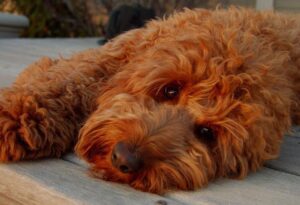
At about 12 weeks of age your puppy might go through a rebellious stage. It is normal for them to test you along the way. Just remain firm and consistent with what you ask them to do. They have a natural desire to please, so avoid working with them if you are getting angry or frustrated. Dogs really pick up on things like our moods, so you won’t be able to hide it if you’re frustrated. Right from the first day you get your puppy, you will need to establish who is in charge, or who is the leader. There are a couple of things you can do to establish yourself as the leader. The first is when you’ve been away from the puppy and you enter the room, chances are they will run up to you and maybe even jump on you. From the beginning we don’t allow jumping, as we don’t care for this behavior. If the puppy jumps up, we simply lift our knee, so that they are met with understanding it’s not ok vs praise for being fun. We use the word “off” at the same time. If everyone does this consistently, the puppy will quickly get the idea and stop jumping up. Once they learn the word “off”, it will also help teach them not to jump on other people, doors, gates, etc. Secondly when they run up to you, don’t give them attention right away. As hard as it is, ignore them (don’t look at them, speak to them, etc) for 5 minutes, then once they are settled down, call them and give them lots of love and attention. The message you are giving them is that you are in charge and will give attention on your terms, not theirs. The third thing you can do involves eating.
Fill their dish with food (while they are watching you) set it on the counter, then get yourself a snack and eat it while they are watching you (the leader always eats first). All members of your family should eat a small snack while your puppy watches and waits. We do not recommend ever feeding your dog “human food”, or allowing begging while we’re eating. We either ignore our dogs while we’re eating, or have them lay in a different room, until we’re done. Here again, ask yourself how you want your adult dog to behave, and what you want to live with for the next 10 plus years.
Page 6
PUPPIES AND DIARRHEA
Diarrhea and loose stools are a very common ailment in puppies. This can be caused by many different things, ranging from something simple to something a bit more complex. We feel that prevention is the best way to avoid and minimize this problem. It is not uncommon for a puppy to get “stress diarrhea” when they are re-locating to their new home. Making sure that there are no other contributing factors added to the stress will help it to clear up quickly. Here is a list of good preventative measures:
- Keep feeding the puppy the same type of food they is used to, if possible. Make any changes to feed gradually.
- Feed 3 small, regular meals. Establishing a routine feeding schedule will help with potty training too.
- Puppies are like babies; they will pick up anything they see on the floor, or the ground, and eat it. Watch them and try to prevent them from eating anything foreign (pine needles, grass, dirt, leaves, cat stool, cat food, people food, bark, wood chips, socks etc.)
- Feed only puppy food or all life stages food, and use it for treats as well, until your puppy is settled in and then introduce just one new treat at a time.
- Don’t give them any rawhide, ever. It can gum up in their system and cause problems.
- Avoid pig ears and other digestible bones and chews. We do encourage dental chews, harder bones, hooves, etc.
- Provide fresh drinking water every. Eliminate all other water sources (especially standing water). Don’t offer water at all times until puppy is fully house trained.
Page 7
HOW TO TREAT DIARRHEA
If your puppy gets diarrhea, even after you’ve done all of the preventative measures that we’ve recommended, there are several steps you can take, before taking him to the vet.
- Give your puppy some of Nancy’s plain, non-fat yogurt and plain, raw, canned pumpkin. They will usually lick it right off of the spoon, or you can mix it in their food.
- Buy some pepto bismol, immodium, or kaopectate. Make sure it has no aspirin in it. Give your puppy a small dose after each loose stool for a few days.
- Feed your puppy a bland diet of boiled white rice, a little boiled chicken or unseasoned beef, scrambled egg, pumpkin and Nancy’s yogurt.
- Make sure your puppy is drinking plenty of fresh, clean water. Check their hydration by feeling their gums. They should be moist, not tacky. You can offer chicken broth (low sodium), if they are not drinking water as the flavor is usually enticing to them.
- Take a stool sample to the vet and ask them to check for parasites and bacteria. They should be able to do this without your puppy going in for an office visit.
Page 8
PUPPIES AND CHILDREN
Many families like to buy a dog for their children, which is really a fantastic idea, providing there is adequate training and supervision of the interaction between the two. Initially when you first get your puppy, they will be teething and if you watch puppies in a litter, they spend lots of time biting and chewing on one another, even making each other yelp in play. You will have to teach your puppy not to mouth or bite on you and your children in playtime, and teach your 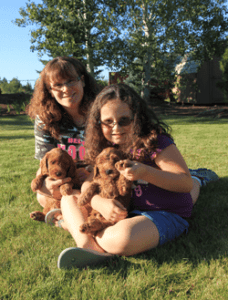 children how to properly discipline your puppy if they do mouth or bite them. The first time your puppy bites or chews on you or your children’s fingers, arms, legs, etc., say “ouch” in a loud voice and stop playing with them. Ignore your puppy for a few minutes and let them know that’s not how you intend to play. Go back to playing or holding them and if they bite or nip again, repeat this. We tell them to “be easy” after saying “ouch” loudly. (It’s nicer if you have them on a leash or in a playpen, so you, or your children, can walk away and they can’t follow you). It is very important for your puppy not to be loose so that they can begin to chase your screaming child down the hall :-). Children running and squealing will only excite your puppy even more. All interaction between your puppy and your children should be supervised, especially when the pup is new to your home. Make sure your children keep their face and eyes out of harms way. Teaching the word “no” is also very important. Say “no” to your puppy in a firm voice and have your children do the same, when they start to do something that you don’t want them to do. Keep your voice calm and stern, not screaming and yelling while instructing your puppy. If your puppy continues to nip and bite, then you need to take it to the next level for discipline. When the puppy bites down on you, or your children, take a firm hold of your puppy’s muzzle and give it a firm but mild squeeze (puppy should whine a little) repeat “no bite”, release his muzzle and if they do it again, squeeze their muzzle harder and repeat “no bite”. Then get up and walk away. Repeat these steps anytime they try to bite or chew on you and/or your children.
children how to properly discipline your puppy if they do mouth or bite them. The first time your puppy bites or chews on you or your children’s fingers, arms, legs, etc., say “ouch” in a loud voice and stop playing with them. Ignore your puppy for a few minutes and let them know that’s not how you intend to play. Go back to playing or holding them and if they bite or nip again, repeat this. We tell them to “be easy” after saying “ouch” loudly. (It’s nicer if you have them on a leash or in a playpen, so you, or your children, can walk away and they can’t follow you). It is very important for your puppy not to be loose so that they can begin to chase your screaming child down the hall :-). Children running and squealing will only excite your puppy even more. All interaction between your puppy and your children should be supervised, especially when the pup is new to your home. Make sure your children keep their face and eyes out of harms way. Teaching the word “no” is also very important. Say “no” to your puppy in a firm voice and have your children do the same, when they start to do something that you don’t want them to do. Keep your voice calm and stern, not screaming and yelling while instructing your puppy. If your puppy continues to nip and bite, then you need to take it to the next level for discipline. When the puppy bites down on you, or your children, take a firm hold of your puppy’s muzzle and give it a firm but mild squeeze (puppy should whine a little) repeat “no bite”, release his muzzle and if they do it again, squeeze their muzzle harder and repeat “no bite”. Then get up and walk away. Repeat these steps anytime they try to bite or chew on you and/or your children.
Page 9
PUPPIES AND CHILDREN
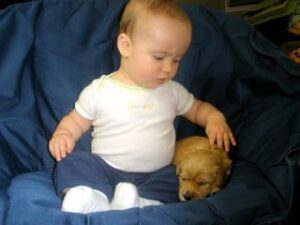 Another issue you might encounter is puppy growling at your children, or you, over a bone or food. If this happens, you need to immediately intervene (growling is normal puppy to puppy behavior, but is unacceptable for puppy to human contact). If your puppy growls at you or your children, immediately say “no growl” take puppy and tap on the nose. Remove the food or bone from their reach. Wait 5 minutes, and give it back to puppy. Reach for the bone, and if they growl again, pick the puppy up and put make serious eye contact repeating “no growl”. Continue this until your puppy does not challenge you when you remove the bone or their food. Once they have learned this with the adults, then with supervision, have your child remove the bone or food. Be quick to discipline if the puppy growls at your child. Early intervention and no tolerance of this behavior, should it occur, is crucial for a well behaved puppy/dog. You may never encounter this situation with your puppy, but we want you to be prepared, if you do.
Another issue you might encounter is puppy growling at your children, or you, over a bone or food. If this happens, you need to immediately intervene (growling is normal puppy to puppy behavior, but is unacceptable for puppy to human contact). If your puppy growls at you or your children, immediately say “no growl” take puppy and tap on the nose. Remove the food or bone from their reach. Wait 5 minutes, and give it back to puppy. Reach for the bone, and if they growl again, pick the puppy up and put make serious eye contact repeating “no growl”. Continue this until your puppy does not challenge you when you remove the bone or their food. Once they have learned this with the adults, then with supervision, have your child remove the bone or food. Be quick to discipline if the puppy growls at your child. Early intervention and no tolerance of this behavior, should it occur, is crucial for a well behaved puppy/dog. You may never encounter this situation with your puppy, but we want you to be prepared, if you do.
Please continue with adult supervision to ensure the safety of both your children and your puppy until he has learned basic obedience.
Page 10
WHAT TO FEED AND WHEN TO FEED IT
It is important to feed your puppy a nutritious diet and there are many good varieties to choose from. There are also many poor choices out there. It may be cheaper, but you’ll end up paying in the long run, when your dog isn’t healthy. One important
factor for me is to feed something that will help my dog have a smaller, harder stool (rather than lots of soft, mushy stool).
Another thing we look for is if my dog’s hair is shiny and has a nice feel. Last, I look for the energy of my dog. If a dog is receiving a balanced diet with all the nutrients they will be happy, healthy, and more balanced overall.
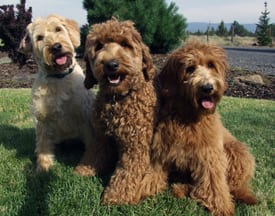
We feed our puppies PawTree food along with NuVet vitamins. The vitamins are given once a day in the morning and are a great supplement to make sure that your dog is getting all the necessary vitamins and minerals they need. We believe wholeheartedly in this food and vitamin. While there are other foods on the market, one thing to look at is reviews and recalls. We believe PawTree stands with an amazing reputation. That is a great sign you’re getting an amazing product!
Puppies need to eat 3 times a day, and getting them on a schedule will help regulate their bowels. We generally feed at 7:00 a.m., 12:00 noon, and 6:00 p.m. We recommend not feeding any later than 6:00 p.m., as it will give your pup plenty of time to have a bowel movement before bedtime. We advise not “free watering” until they are potty trained. Offer water at meals or other times when you feel they need it but only when you can take them directly outside. We also do not give water after 6:00 p.m. to aid with sleeping through the night. We don’t recommend “free feeding” as it can cause your pup to become a picky eater. We give them about 20 minutes to eat, then we pick it up and wait until the next time. Drop back to twice a day, once they’re 5-6 months old, once in the morning and once in the evening.
Page 11
PLAYTIME AND CHEW TOYS
It is very important for your puppy to have some good, hearty play time. Taking him on walks with you will help them learn to walk on a leash, and will give them good exercise. Running around and burning up some of that energy will also help them sleep through the night. You should be careful not to overdue it with your puppy, as they do tire easily. Your veterinarian can give you guidelines on what would be too strenuous for your puppy’s age and development. We do not recommend having them jump up in the air to catch a Frisbee or anything that would cause them to come down hard on their back legs, until they are fully developed, as it could cause damage to their joints. When throwing a ball for your puppy/dog, please make sure the ball is large enough that it would not be able to go down his throat and lodge there (tennis balls are a good size). We do not advise running with your dog until at least 6 to 9 months to allow their joints to develop.
We provide our dogs with a variety of chew toys ranging from real bone to hooves to rope. We do not recommend rawhide, as it can gum up in their intestines and cause problems.
You can buy Kongs, which work well, only if you take the time to stuff them & typically freeze them. We use peanut butter, cheese, yogurt or canned dog food for stuffing (the one exception to human food).
Tug of war is another game dogs love to play, but it can be harmful to their teeth, so use caution with this. It’s fun to play “hide and seek” with them. Once they catch on, you’ll be amazed how good they are at finding you! Hiding little treats around the house for them and watching them find them is also lots of fun.
Page 12
YOUR LABRADOODLE PUPPY
Your puppy may have a high or low maintenance coat, depending upon how long the hair grows and how thick it is. It is important to get him used to being brushed, all the way to the skin. We like to use a coat rake for this. You’ll want to keep the hair trimmed around their genitalia, so they don’t collect feces or get infections there. Also make sure to check their ears and toenails regularly (or have your vet do it). Dogs that have ears that hang down, and are hairy are prone to ear infections. This is easily remedied by keeping the ears clean and dry with ear wash that can be bought from PawTree, Life’s Abundance, or NuVet.
The wool or overly curly coats will tend to be higher maintenance as their hair will typically grow longer, thicker, and be curlier (more prone to matting). You should plan on combing or brushing them out daily or every other day. Most of these dogs will be non-shedding, however just like humans they will lose hair from time to time. Expect a higher maintenance coat at 8-12 months when they lose their puppy coat and gain the adult coat.
If you like the curly look, let the hair dry naturally after a bath.
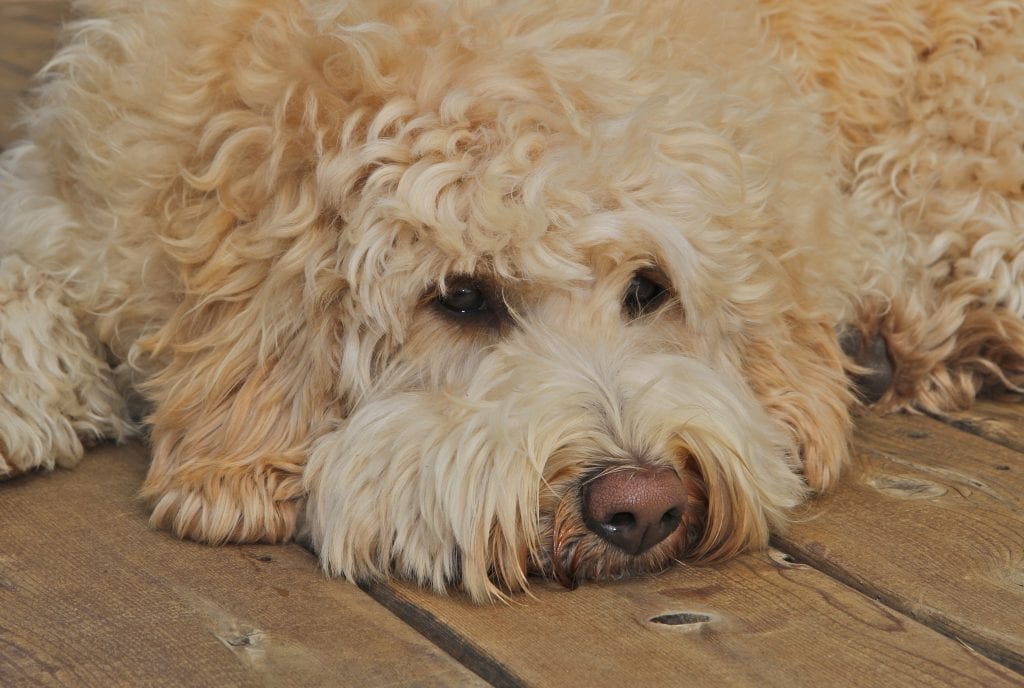
Page 13
PUPPY-PROOFING YOUR HOME
There are a number of harmful, common household items that you’ll want to make sure your puppy can’t get a hold of:
- Anti-inflammatory medications (aspirin, ibuprofen etc)
- Acetaminophen
- Cold and Flu medications and Diet Pills
- Antidepressants and Vitamins
- Home insect products
- Rat, Mouse, Slug and Snail bait
- Disinfectants and Bleach
- Fabric softener
- Lead (pencils)
- Lighter Fluid
- Mothballs
- All cleaning products (oven cleaner, drain, detergents)
- Tobacco products
- Alcoholic beverages
- Antifreeze, gasoline, oil and de-icing salts
Harmful foods include:
- Avocados, onions, garlic, grapes, raisins
- Chocolate in all forms
- Macadamia nuts, and fatty foods
- Gum, candy or foods sweetened with xylitol
- Raw yeast dough
- Moldy or spoiled foods
- Salt
Objects that can be harmful
- Balls that are too small, or have a smooth coating
- Batteries, paper clips and rubber bands
- Bread twist ties and plastic wrap
- Buttons and any sharp objects (nails, needles, scissors)
- Coins
- Cotton swabs, dental floss, string, yarn
- Glass and wax
- Hair pins and Jewelry
- Nylons and Socks
For more information on poisons, call 1-888-426-4435
Page 14
HOW TO HANDLE PROBLEM BEHAVIORS
It would be very unusual if you didn’t encounter some problem behaviors along the way. The first one you might experience is when your sweet, little puppy chomps down on your fingers and it hurts! When puppies play with one another, they bite, chew, growl and can be downright vicious. Your puppy needs to learn that this is not how you want to play with him. If he bites down hard on your fingers, say “ouch” and say no. Stop playing with him and walk away. Be consistent every time he does this with you and he will quickly learn this is not how you want to play. Divert his attention with something he can chew (see pgs. 8-9).
Jumping up is another behavior that could be a problem, especially with young children, who throw their arms in the air and squeal, and run. This excites a young puppy and he will want to chase and jump up. It’s important to teach the children, as well as the puppy, that this is not how to behave. Teach your children to stand still and raise their knee, if the puppy jumps up. Step in and help by firmly telling him “no” and “off”. If everyone uses these words, he’ll soon learn what they mean.
Almost everyone has an occasion where they take their puppy outside, they gets sidetracked by something and you say “come” and they keep right on running the other direction. Sometimes they’ll even look at you and then run the other way. You want to avoid chasing them, unless you absolutely have to for the sake of safety. Puppies love to play the “chase me” game, and it’s not one you want them to learn let alone perfect! If you have problems with this we recommend, before you go outside, that you attach a light line (like a clothes line) that’s 15 to 25 feet long, to their collar. Hold tightly to the other end and when it comes time for them to come, get their attention, and say “come”. If they take off another direction, hold firmly to the end of the line, turn and abruptly walk away from them. They will come to the end of their rope, and be in for a rude awakening when they gets upended. They’ll look back at you and see you going the other way. Stop and repeat the command to “come” and if they don’t come, reel them in. Don’t scold them, but keep encouraging them to come to you.
Page 15
HOW TO HANDLE PROBLEM BEHAVIORS
Always reward your puppy for coming to you, even if it’s after they’ve run the other way. If you start this when they’re young, it should never be a problem when they become an adult. If they get wise to the line attached to their collar, and only obey when they have it on, then you can fool them by attaching a short piece of line. They won’t know how long it is and the weight of the line will fool them into thinking you’ve got the other end.
Barking is another potentially problem behavior. You might like a little warning bark, if it alerts you that someone is at your door. The main thing I want our dogs to understand is that once we see the person and say “it’s o.k.” then we want them to stop barking. We use the command “no barking”. First we tell them it’s o.k., then we say “no barking”. We consistently use this anytime we don’t want them to bark. If they are outside, we tap loudly on the window and they get the message. Give plenty of praise when they stop on command.
Regarding potty training, there will be some dogs that have a hard time learning to hold it and/or learning to communicate with you their need to go outside. We think of it this way “each time they go outside is a step forward, and each time they go inside is two steps backward”. It’s very important in those first few months to be consistent and not let the puppy have the run of the house. It is so much harder to break a bad habit than it is to teach a good one. If you’ve done everything you can, and you have a pup that’s having a hard time learning, hang in there! Continue to work at it, don’t get angry and rub their nose in it, but do try to catch them in the act, so you can make it clear that’s not ok, then promptly take him outside and say “go potty” positively. Limit their free area to a small space until they can control themselves in that small area, then gradually expand the area. Don’t let them out of your sight though! If you can’t watch your puppy, then give them a time-out in their crate. Some pups will have this down by the time they’re 3 months old, and some may take up to 1 year before they’ve mastered it. Much of it will depend on how you handle those first few weeks and how consistent you are with them. Just remember to be patient, loving, firm, and consistent.
Page 16
WALKING ON A LEASH
When your puppy is small it should be fairly easy to get them to walk by your side on a leash. Always have them walk on your left side and next to you, rather than in front of you. Once they gets a little older, and bigger (around 6 months old) they may start trying to lunge ahead and pull on the leash. We prefer to be the one walking our dog, not our dog walking us, so if you’re having this problem, then try the following suggestio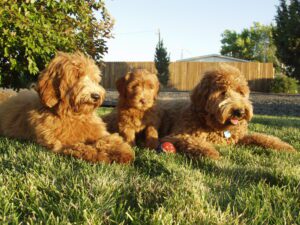 ns.
ns.
Begin the training session by putting your pup in their crate for one hour. When you take them out, don’t talk to them, as you’re going to be working on “attention training”. You’ll need to have a 15 foot cotton rope—something that won’t give them a rope burn, if they get tangled in it. You will also need a working area that is open, like a field or park. To begin, take them out of the crate and attach the 15 foot line to the collar. Walk to the open area. Firmly grasp the end of the line in your hands and you will begin by briskly walking in a straight line for about 20 yards. Remember not to talk to, or look at your pup during this time. When you come to the end of the 20 yards, stop and wait. Your pup will run up to you and then will most likely get distracted and start sniffing around. You will wait until they are not looking at you, and is distracted, then turn a 45 degree angle and begin briskly walking for about 20 yards (the idea is to walk in a square pattern, stopping at the corners). When you stop at the corners, chances are your pup will get distracted and wander off away from you. When you abruptly turn and walk the other direction, they’ll get caught off guard and may get jerked or pulled by the long line. This is o.k., because they’ll look up and see you walking the other direction. In their mind they will think “there goes my owner (my leader) and I’d better start paying closer attention”. It won’t take long and your dog will start watching you, to make sure you don’t leave without them. It’ll be harder to catch them off guard. Once you get to the place where they continue to watch you and do not get distracted, even by a cat, ball or other people, then you’ll be ready for the next step. It may take several sessions, spaced over a week, or so, to achieve this. When you’re done with a session, put them back in the crate for another hour.
Page 17
WALKING ON A LEASH
The reason for crating one hour prior and one hour after each session, is so they will view the session as fun, not work. Once you have completed this attention training, and you always have their attention while working on the long line, then you’ll be ready to work them on their leash. In the beginning, always put them in the crate before working for one hour and afterward for one hour. When you take them out and begin working on the leash, you can talk to them and praise them when they do well. Attach the leash to their collar, give the command “heel” and start walking. Offer them a few treats when they are walking calmly next to your side. The idea here is that life is good when they are right where they should be, and is paying attention to you. If they get ahead of you, grasp your end of the leash with both hands, turn away at a 45 degree angle, and abruptly walk away. This may jerk them a bit and they’ll look up and see you walking away. They should run to catch up and be looking up at you. Always reward with either praise or a treat when they are looking up at you and walking right next to your side.
When we are out walking our dog, and run into a friend, or stop to do something, the last thing we want is our dog walking circles around us, getting us all tangled in their leash. You can remedy this by having them sit, anytime you stop walking. This also will help teach them not to bolt across a street without looking. Walk up to the street corner and stop, ask them to sit and wait, looking both directions to make sure there’s no traffic coming before crossing.
We highly recommend taking your dog to an entry level obedience class. Even though you’ve already taught the basic commands of sit, stay, come and heel, the test will be how they behaves in a group of other dogs. This will be a good social event for both of you!
Another activity that might be fun for both of you is an agility class. Several of our Labradoodles have gone through agility training and they love it!
We can’t recommend Baxter & Bella enough! This tool will be such an important resource for you. Don’t forget to get 25% off by using promo code MTVIEW when you sign up!
First and foremost, enjoy your dog! They are great companions!
Mountain View Doodles, LLC
Copyright © 2015 [Mountain View Doodles]
All rights reserved.
